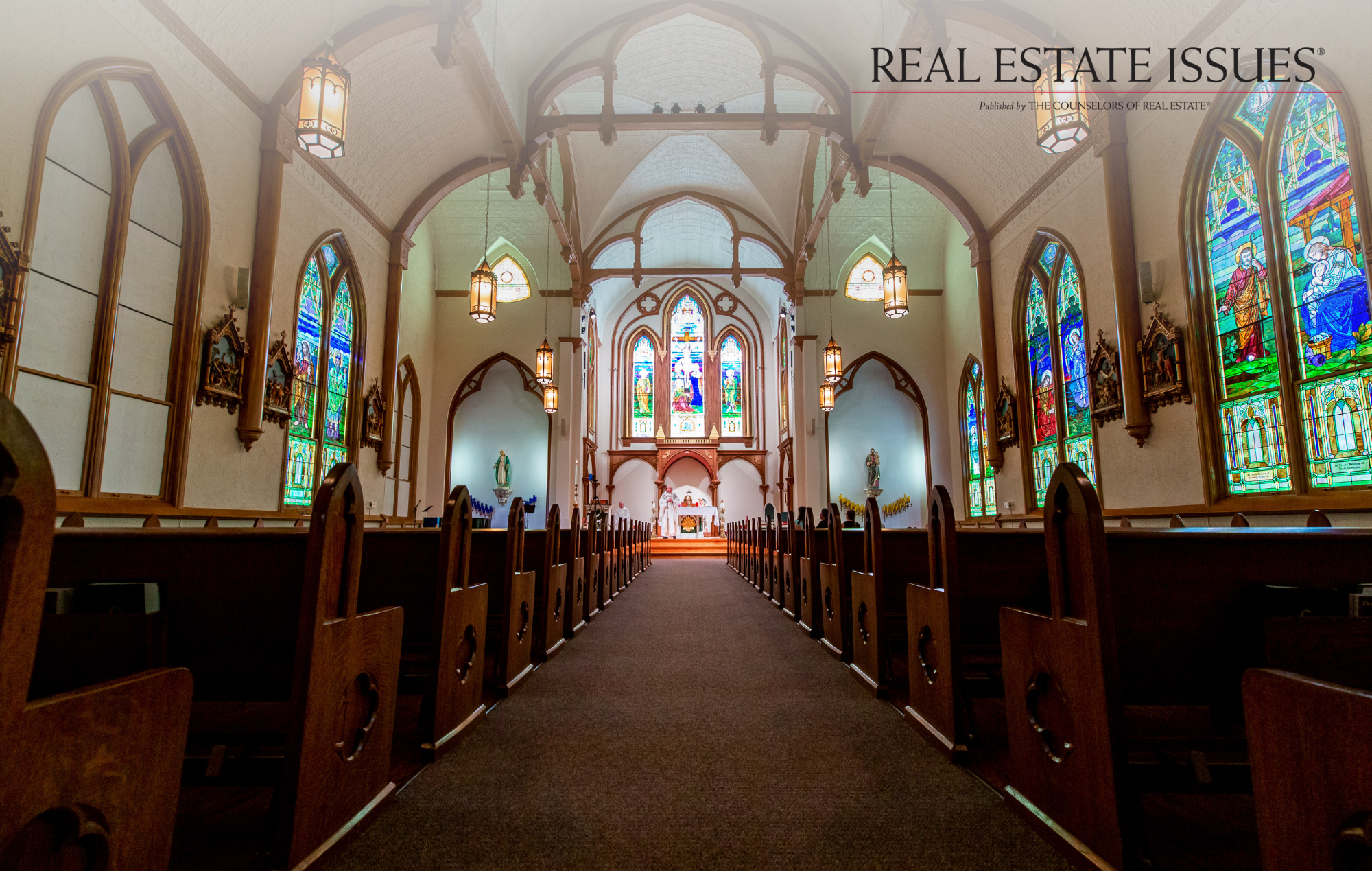OVERVIEW
What declining department stores were to our municipalities in the late 20th and early 21st century, emptying houses of worship are today, only the challenges are more vexing.
A tsunami of emptying houses of worship is washing across the U.S., from denomination to denomination, from coast to coast. The former Vice President of Research and Planning of the National Council of Churches estimates that 100,000 houses may be closed over the next decade.
Why the tsunami? A perfect storm. Americans, especially younger generations, are shying away from attending services. A 2021 Gallup poll showed that over the past 20 years, church membership plummeted from 70 percent to 47 percent of Americans; projecting that decline a generation forward may tell an even greater story.
Real estate operating costs are up, especially for utilities, insurance, and repair, exacerbated by aging facilities overdue for repair. Estimates are that it costs congregations $7-10 per square foot just to operate church buildings, never mind paying for staff or services.
Personal mobility and internet connectivity have undergone a revolution. In the 19th century worshipers either walked or rode horseback to services. Today with one click of the computer, neighborhood houses of worship compete with those from all over the globe, as with one click, worshipers can join services of the Pope or the Dalai Lama.
Finally, Covid-19 threw a giant monkey wrench into the works; Covid drove people away from services who never returned or moved to online services for the convenience and accessibility.
COMMUNITY EFFECTS
The effect of emptying houses of worship on the real estate of our cities, towns, and villages is profound. A few examples:
- The Planning Director of Gary, Indiana, reports that her city of 68,000 is the site of more than 250 empty churches.
- The Greater New Jersey Annual Conference of the United Methodist Church rated its 500-plus churches on 10 factors and found 20 percent to be in critical condition (tiny congregation and desperate finances), 40 percent right behind in serious condition, and only 40 percent in fair-to-good condition.
- The Roman Catholic Diocese of Buffalo just announced closure of 70 churches throughout Western New York. Not only have Catholics pulled back on attending church, but also a U.S. Bankruptcy Court judge has ordered the Diocese to turn illiquid assets into cash to pay $100 million in damages to those sexually abused by priests. Many more dioceses face the same fate.
IMPORTANCE
Houses of worship are critically important to communities. Of course, they provide places for people to connect with their faith and experience life’s most important events—baptisms, weddings, and funerals—but they command other importance to the community at large.
Houses of worship deliver social services, serving as food pantries, clothing closets, childcare operations, health clinics, and 12-step personal-improvement groups. Partners for Sacred Places, a not-for-profit organization headquartered in Philadelphia, working with the University of Pennsylvania, has identified an “economic halo effect” of more than $140,000 per year’s worth of human services provided by the average urban church. They estimate that the economic impact of the average urban historic church is more than $1.7 million per year.
Houses of worship are community icons. Cities often have sprung up around churches. Community founders are buried in church graveyards. It’s tough to imagine a community postcard that doesn’t feature church steeples.
UNCERTAINTY
When houses of worship are endangered, it is inadequate for public, private, and not-for-profit leaders to rely upon faith leaders alone to come up with the answers.
Religious leaders learn little about finance, real estate, or urban planning in divinity school, even though upon graduation they are assigned to manage substantial properties.
Houses of worship are also places of emotional importance to members of the community. It is difficult to see negative change come to the place where you were married, your parents were memorialized, and your children were baptized and confirmed or bar mitzvahed.
Reuse and redevelopment of faith properties often requires agreement from not only the congregation but also the judicatory, i.e., the diocese, annual conference, presbytery, or the like. The more officials are involved in making the decisions, the more difficult it can be to reach consensus. Roman Catholic and Mormon churches are historically oriented to make decisions top-down, whereas Baptist, United Church of Christ, Unitarian Universalist, and Reformed Judaism congregations tend to have more of a parish-level bottom-up polity. Most mainline Protestant denominations require a difficult-to-achieve consensus between the church and the judicatory.
For those in the real estate industry, time is money. Developers often become frustrated by the lack of clear, crisp decision making from religious institutions, never mind the delays that can be caused by public review. One church-property redevelopment into affordable housing completed this year took 18 years from concept to ribbon-cutting.
DIFFERING DEMAND
In communities experiencing hot real estate markets, developers wait eagerly to turn faith properties into trophy projects, especially mixed-use developments featuring residences. Not so in communities experiencing cold real estate markets, where it is more likely that a house of worship closes and the property deteriorates.
So in Pensacola, Petaluma, or Punxsutawney, the problem is likely to be one of potential neighborhood blight. In Manhattan, Miami, or Minneapolis, the problem more likely is one of opportunity cost: how can a community rally to maintain significant community space, worthy architecture, and community history. Developers may fight over control of the latter while shying away from the former, convinced that redevelopment may lose money, even with government subsidy.
Rather than relying solely on faith institutions, organizations like business improvement districts, redevelopment agencies, community foundations, and the like can act as the translators and facilitators needed to bring a difficult project to fruition.
REUSE/REDEVELOP/RECYCLE
Faith institutions aiming to find better uses for their surplus properties can pursue three possible avenues:
- Reuse. Faith leaders can use their current properties in new ways. For decades, houses of worship have housed food pantries, clothing closets, childcare centers, and health clinics. Houses of worship under financial pressure might seek uses that can produce increased revenues, through social entrepreneurship or leasing entities with the wherewithal to pay rent or fees.
- Redevelopment. Faith leaders can build new developments or gut or demolish and rebuild their current properties. The latest trend is to redevelop surplus properties into affordable housing, allocating the surplus of faith real estate to address the national shortage of affordable housing. Market-rate housing, office, retail, and institutional uses are possible as well.
- Recycling (sales). Many houses of worship and their denominations simply sell closed or underused properties to the highest bidder, using the cash proceeds to support their entities. First United Methodist Church in Downtown Miami sold to a private developer for $55 million.
INITIATIVES
State governments, local governments, religious bodies, and other not-for-profit corporations have begun to marshal resources to promote and incentivize reuse and redevelopment of houses of worship
California has led the way for state governments by passing in 2023 SB 4, the Affordable Housing on Faith Lands Act. Maryland and Washington State have passed similar legislation, with Arizona, New York, and Virginia considering variations.
A handful of municipalities have formed initiatives to unlock the potential of surplus faith properties by offering density bonuses, accelerated approvals, and/or pre-development funding, including Atlanta, Portland, San Antonio, San Diego, and Seattle, as well as Montgomery County, Maryland, in the Washington D.C. suburbs.
A few religious bodies have formed not-for-profit entities to manage redevelopment projects. The United Church of Christ Church Building and Loan Fund has managed such projects since pre-Civil War times.
Other secular not-for-profit corporations work with faith institutions on projects as well, such as Enterprise Community Partners, the Local Initiatives Support Corp., and Partners for Sacred Places.
TO DOs
Dr. Nadia Mian, Senior Program Director at the Ralph W. Voorhees Center for Civic Engagement at Rutgers University, and I developed a list of must-dos for our Planning magazine cover article, “Transforming Empty Churches Into Affordable Housing Takes More Than a Leap of Faith.” While the list of suggested actions is for city planners, it applies just as well to real estate professionals.
- Collect and analyze data. How many underused houses of worship are still active? How many are closed? Which ones are in trouble? Are any interested in doing mission-based real estate development?
- Build relationships. Act as convener and collaborator for houses of worship. Understand the goals and even the vocabularies of religious organizations — as well as those of developers, city agencies, and financiers. Ask whether planners can play matchmaker for potential collaborators.
- Review and update zoning and other policies. Are your jurisdiction’s zoning laws, building codes, permitting processes, or property tax policies prohibitive to redevelopment? Can they be changed, even in incremental ways? Cross-sector collaborations with engineering, transportation, and housing departments might be necessary.
- Identify funding sources. Developing affordable housing often means cobbling together and leveraging multiple funding sources. Besides faith-based lenders, traditional banks, and social impact investor groups, look to government grants, subsidies, bonds, and tax incentives. Locally, inclusionary zoning programs, housing levy programs, and bonds issued by housing authorities could apply, while federal sources might include COVID-19 relief funds and tax credits, like low-income housing tax credits.
- Create capacity building programs. Real estate leaders and urban planners can educate faith-based organizations about zoning, entitlements, market conditions, and financing, as well as host technical workshops and consultations with developers. Using a cohort-based model, external partners such as Enterprise Community Partners, LISC, and Partners for Sacred Places provide resources, funding, and access to networks to facilitate faith-based affordable housing development. In any case, trusted partners who understand all sides–faith, municipal, and real estate–are a critical factor in the equation.
CASE STUDIES
The Opal, Portland OR (HUD case study)
https://www.huduser.gov/portal/pdredge/pdr-edge-inpractice-062524.html
Gilliam Place, Arlington VA (HUD case study)
https://www.huduser.gov/portal/pdredge/pdr-edge-inpractice-042020.html
St. Austin Catholic Church and School, Austin TX
Pico Union, Los Angeles
Southpark Church, Charlotte NC
https://www.charlottemagazine.com/a-resurrection-on-sharon-inside-southpark-churchs-transformation/
LINKS
Cooperative Baptist Fellowship: Sacred Spaces, Innovative Places 06-24-22
Partners for Sacred Places: Transitioning Older and Historic Sacred Places 08-10-21
https://sacredplaces.org/info/publications/transitioning-older-and-historic-sacred-places/
Planning 05-05-23 “Transforming Empty Churches into Affordable Housing Takes More Than a Leap of Faith” (with Nadia Mian) https://www.planning.org/planning/2023/spring/transforming-empty-churches-into-affordable-housing-takes-more-than-a-leap-of-faith/
Urban Land 02-20-24 “Affordable Housing: YIGBY (‘Yes in God’s Backyard’) Movement Seeks to Counter NIMBY Movement” https://urbanland.uli.org/property-types/housing-affordable-and-workforce/affordable-housing-yigby-yes-in-gods-backyard-movement-seeks-to-counter-nimby-movement
Governing 07-05-24 “Can Struggling Houses of Worship Be Turned into Housing? Not Always” https://www.governing.com/urban/can-struggling-houses-of-worship-be-turned-into-housing-not-always


 @Sara Carpenter/Shutterstock.com
@Sara Carpenter/Shutterstock.com



